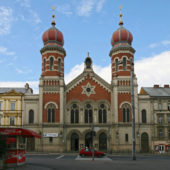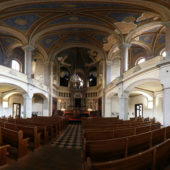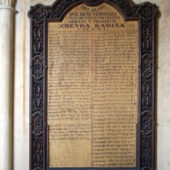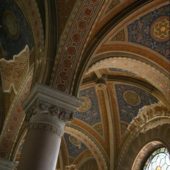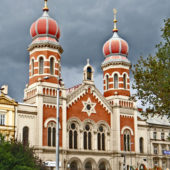Touted as the second largest synagogue existing today in Europe.
Touted as the second largest synagogue existing today in Europe, the Velka (Great) Synagogue of Plizen is truly a monument to a late 19th Century Jewish community of about 2,000-3,000 that was brimming with confidence and enthusiasm. That enthusiasm is evident in the somewhat eclectic design of the building which features Romanesque, Moorish and even Russian architectural influences as seen in the twin onion domes that sit atop the synagogue’s twin towers.
A Viennese architect by the name of Fleischer drew up the original plan including 65 meter high towers. The town council of Plizen, however, rejected the plans in part because the towers would have competed with the spires of St. Bartholomew’s Cathedral for dominance of the city’s skyline.
Architect Emmanuel Klotz revised the plans and lowered the towers by 20 meters. The synagogue was completed in 1893 for what was considered a reasonable sum of 162,168 guilders. The interior features gothic style flying buttresses and ceiling design elements reminiscent of Islamic art. The exterior was marked by an enormous Star of David as well as the distinctive towers and domes. Inside, the synagogue easily accommodated the entire Plizen Jewish community.
The Nazi era decimated Plizen’s Jewish population and the synagogue was slated for destruction. However, because it was attached to adjacent buildings, the synagogue was spared and instead used as a Nazi munitions facility and auction house for items plundered from Plizen’s Jews.
The synagogue came back into use in the post war communist era but the last service was held in 1973. A period of slow decline set in until the late 1990s when the Czech government poured in about $1.5 million to renovate the synagogue. In February 1998, the synagogue was reopened in a service that included well-known cantor, Joseph Malovany, as well as many government and Jewish dignitaries. Today’s total Jewish population in Bohemia numbers around just 100 and the use of the synagogue as a place of worship for such a small number remains uncertain. The synagogue is used from time to time as a concert hall and to host photographic exhibits.

